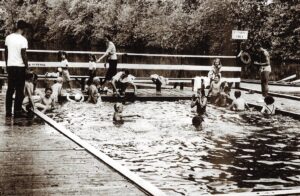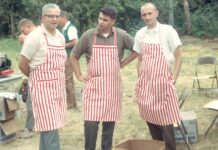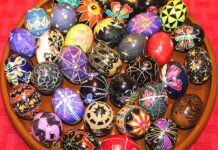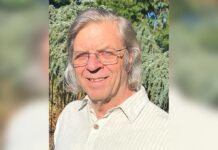Early Tigard, or Tigardville as it was known from 1886 to 1908, was essentially a farming community, and its inhabitants enjoyed numerous pastimes and sports spawned by prosperity. The most visible form of recreation for young men was the Tigardville Baseball Team, whose jerseys were adorned with “Tigardville” in an arc across their chests and worn with short pants and knee-high socks. The Tigardville Baseball Team members were amateurs who played in a league called the Tualatin Valley League. The circuit of cities played were Beaverton, Hillsboro, Verboort, Forest Grove, and Tigardville. The teams competed for an annual Championship Baseball trophy and had local sponsors and fans. This league inspired sportsmanship, athleticism, and civic pride. Baseball had been invented nationally in 1839 by Abner Doubleday in Cooperstown, NY. Each team had nine players, and played on a “diamond” shaped field for nine innings (times at bat). By 1903 a World Series had been established between the American and National Leagues.
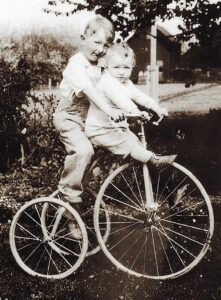
The Tigardville team members were local young heroes and came from all walks of life and professions. Baseball emphasized the value of health and exercise and was often associated with community events such as company picnics or groups such as the Boy Scouts. One of the favorite local players was William “Willie” Tigard, the eldest son of Charles Tigard, who had established the Tigardville General Store on Pacific Highway. Willie later drowned while on a trip to Alaska.
Boxing was another favorite local sport, and its outstanding practitioners were the Scheckla Brothers. The Bartholomew and Tekla Scheckla family had migrated to Tigardville in 1881 and purchased land for a farm where Tigard High School is today on Durham Road. The family purchased 40 acres, a part of Solomon Richardson’s donation land claim, and had nine children – Mamie, Frank, Fred, Rose, Gustav, Annie, Joseph, John, and Albert. Around 1900, boxing in America had become a manly sport, with President Theodore Roosevelt advocating its virtues for fitness. The Scheckla brothers practiced boxing, and their rounds were timed as they learned to defend themselves for manly self-protection. Boxing had been a sport since ancient Egypt, Greece, and Rome, and the rules were developed in England, where it was viewed as a gentlemanly sport.
Several words and phrases are associated with boxing and have entered the American vocabulary. ‘Toe the mark’ was an expression that meant that boxers were required to come up to the line scratched in the dirt, which divided the ring to prove they were fit to fight. “To come up to scratch” meant the same thing. The term “stakes” or “high stakes” comes from the posts or stakes placed in the ground to hold the ring ropes, and a bag of money was tied to one of the stakes for the winner of the bout to claim at the fight’s end. If there was no conclusive winner, the stakes were “drawn” from the ground, the ropes taken down, and a “draw” proclaimed, meaning a tied score. The earliest rules were the London Prize Ring rules, and in 1867 the Amateur Athletic Club devised the Queensbury Rules, named after the patronage of the 9th Marquess of Queensbury, which attracted the upper-class English patron. The new rules introduced padded gloves, a round was fixed at three minutes followed by one minute of rest, wrestling was deemed illegal, and a knockdown and out was determined after a fighter was unable to get up after ten seconds. The fighters were evenly matched in skill and weight. At the turn of the 20th Century, American boxers or pugilists came to dominate the sport. The word pugil meant a “boxer” in Latin from the word pugnus “fist” from the Greek word pyx “clenched fist.” Prize fighting meant fighting for monetary gain or reward.
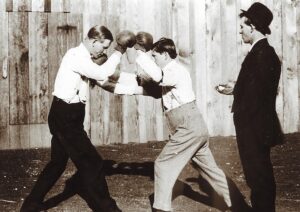
Another family sport was bicycling, with all ages participating. The bicycle was developed in 19th-century Europe after a famine and crop failure in 1816, which caused many horses to die off. An alternative form of transportation was sought, and in Germany, Baron Karl von Drais, the “father of the bicycle,” designed his Laufmaschine – a “running machine.” This early bicycle prototype was called a Draisine in English and went on to develop many forms, including the tricycle and the quadricycle. Eventually, cars replaced the bicycle around 1910-1920, and the bicycle became a children’s toy rather than a must-have form of transport.
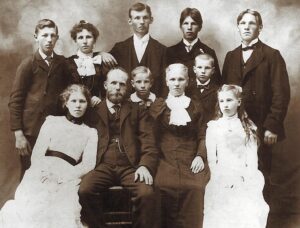
Youth and adults used the Tualatin River as a recreational site, especially during World War II and the 1950s when floating swimming docks were built by motels along the river for their guests and the public. Roamer’s Rest was a swim park that attracted youth of all ages, and the clean water of the Tualatin became the center of recreational activities. The swimming park was the hub of good clean fun! Sports in early Tigard, just as today, cultivated mind, body, and spirit.
To become a member, volunteer, or for more information about the Tigard Historical Association visit www.tigardhistorical.org.







